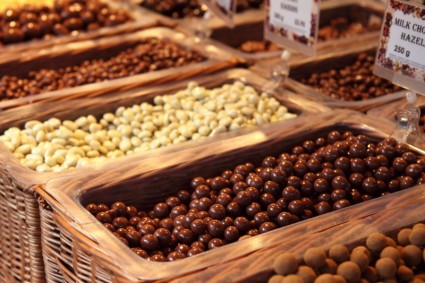The subject of wine and chocolate is often reserved for Valentine’s Day and other romantic occasions. But over the past few months the question of chocolate’s pairing with wines has come up multiple times. So much so that it is now a two-part section for my students in Food and Wine Pairing class at Little Rock’s Pulaski Technical College’s Culinary Arts and Hospitality program. Wine and chocolate are similar in details.
The production process of chocolate is important because, just as wine has complexity in its birth, so does chocolate. Cacao trees grow in rain forests in a band that spans 20 degrees north and south of the equator.
Fruit pods hang from the trunks of the trees. The beans develop inside the pod and are surrounded by a sweet, white pulp. The pods are harvested by hand, then placed in earth pits, covered with banana leaves and allowed to ferment. Just as with wine, this is the state in which the fruit develops aromas, color and complexities as sugars turn to acid. After a week or so of fermentation the pods are dried, sorted and shipped to a production facility. At the factory, the beans are roasted. During this process, the outer shells crack, revealing the “nibs,” known as the “meat” of the cacao bean. The nib is crushed by mechanical rollers, and the friction causes the nibs to turn into a liquid. It is this stage that determines if the nibs will be made into cocoa (powder) or chocolate (solid).
I find it interesting that a chocolate assessment follows similar guidelines as professional wine tasting.
First the appearance. What is the color: Is it pale or dark, radiant or dull? Assess the colors based on shades ranging from brown to black, white to ivory, and yellow to gold.
Next is texture. The better the quality of chocolate the more distinct the cracking sound when you break it. Place the chocolate close to the ear for more detailed sounds. Examine the edge of the break. Quality chocolate should have a clean break and usually not a crumbly or jagged one.
Followed by aroma. Fine chocolates tend to have a broader range of complexity in aromas. Smell the chocolate: Do you detect notes of milk, honey, flower, caramel, nuts, vanilla, roasted nuts or even herbs?
Of course tasting will complete the process. Take a small piece of chocolate in your mouth. Observe the level of sweetness, fruitiness, earth tones and subtle roasting characteristics. Finer chocolates will melt more slowly, offering a more detailed perception of flavors and characters.
For pairing with milk chocolate:
THE VALUE
- 2014 Chloe Pinot Noir, California (about $12 retail)
The Splurge
- NV Cockburn’s 20 Year Tawny Port, Portugal (about $45 retail)
For pairing with dark chocolate:
THE VALUE
- 2013 Ravenswood Lodi Zinfandel, California (about $14 retail)
THE SPLURGE
- 2013 Keenan Napa Valley Cabernet Sauvignon, California (about $47 retail)
